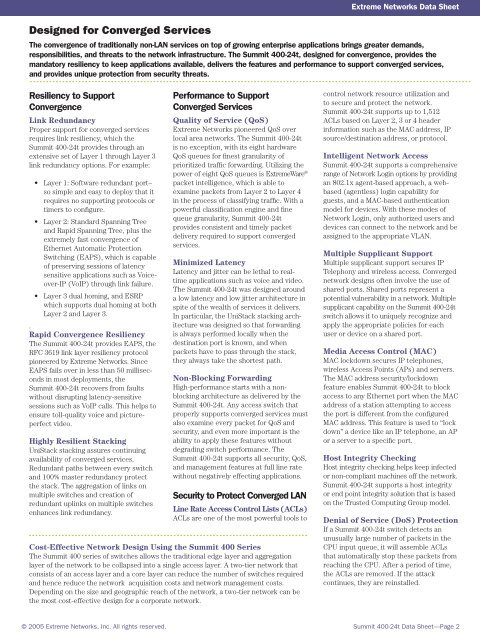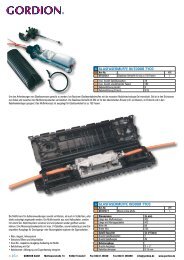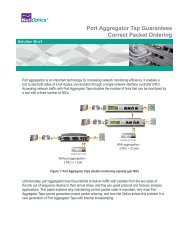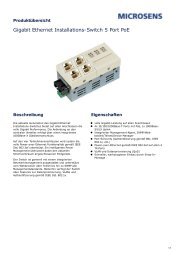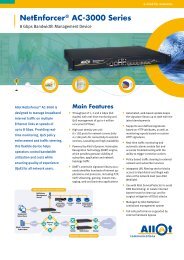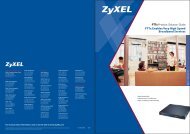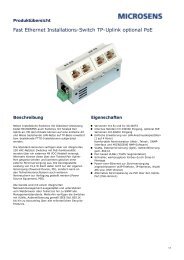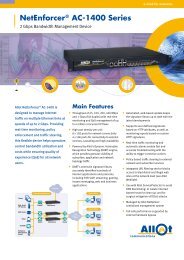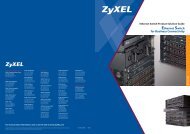Create successful ePaper yourself
Turn your PDF publications into a flip-book with our unique Google optimized e-Paper software.
Extreme Networks Data Sheet<br />
Designed for Converged Services<br />
The convergence of traditionally non-LAN services on top of growing enterprise applications brings greater demands,<br />
responsibilities, and threats to the network infrastructure. The Summit <strong>400</strong>-<strong>24t</strong>, designed for convergence, provides the<br />
mandatory resiliency to keep applications available, delivers the features and performance to support converged services,<br />
and provides unique protection from security threats.<br />
Resiliency to Support<br />
Convergence<br />
Link Redundancy<br />
Proper support for converged services<br />
requires link resiliency, which the<br />
Summit <strong>400</strong>-<strong>24t</strong> provides through an<br />
extensive set of Layer 1 through Layer 3<br />
link redundancy options. For example:<br />
• Layer 1: Software redundant port–<br />
so simple and easy to deploy that it<br />
requires no supporting protocols or<br />
timers to configure.<br />
• Layer 2: Standard Spanning Tree<br />
and Rapid Spanning Tree, plus the<br />
extremely fast convergence of<br />
Ethernet Automatic Protection<br />
Switching (EAPS), which is capable<br />
of preserving sessions of latency<br />
sensitive applications such as Voiceover-IP<br />
(VoIP) through link failure.<br />
• Layer 3 dual homing, and ESRP<br />
which supports dual homing at both<br />
Layer 2 and Layer 3.<br />
.<br />
Rapid Convergence Resiliency<br />
The Summit <strong>400</strong>-<strong>24t</strong> provides EAPS, the<br />
RFC 3619 link layer resiliency protocol<br />
pioneered by Extreme Networks. Since<br />
EAPS fails over in less than 50 milliseconds<br />
in most deployments, the<br />
Summit <strong>400</strong>-<strong>24t</strong> recovers from faults<br />
without disrupting latency-sensitive<br />
sessions such as VoIP calls. This helps to<br />
ensure toll-quality voice and pictureperfect<br />
video.<br />
Highly Resilient Stacking<br />
UniStack stacking assures continuing<br />
availability of converged services.<br />
Redundant paths between every switch<br />
and 100% master redundancy protect<br />
the stack. The aggregation of links on<br />
multiple switches and creation of<br />
redundant uplinks on multiple switches<br />
enhances link redundancy.<br />
Performance to Support<br />
Converged Services<br />
Quality of Service (QoS)<br />
Extreme Networks pioneered QoS over<br />
local area networks. The Summit <strong>400</strong>-<strong>24t</strong><br />
is no exception, with its eight hardware<br />
QoS queues for finest granularity of<br />
prioritized traffic forwarding. Utilizing the<br />
power of eight QoS queues is ExtremeWare ®<br />
packet intelligence, which is able to<br />
examine packets from Layer 2 to Layer 4<br />
in the process of classifying traffic. With a<br />
powerful classification engine and fine<br />
queue granularity, Summit <strong>400</strong>-<strong>24t</strong><br />
provides consistent and timely packet<br />
delivery required to support converged<br />
services.<br />
Minimized Latency<br />
Latency and jitter can be lethal to realtime<br />
applications such as voice and video.<br />
The Summit <strong>400</strong>-<strong>24t</strong> was designed around<br />
a low latency and low jitter architecture in<br />
spite of the wealth of services it delivers.<br />
In particular, the UniStack stacking architecture<br />
was designed so that forwarding<br />
is always performed locally when the<br />
destination port is known, and when<br />
packets have to pass through the stack,<br />
they always take the shortest path.<br />
Non-Blocking Forwarding<br />
High-performance starts with a nonblocking<br />
architecture as delivered by the<br />
Summit <strong>400</strong>-<strong>24t</strong>. Any access switch that<br />
properly supports converged services must<br />
also examine every packet for QoS and<br />
security, and even more important is the<br />
ability to apply these features without<br />
degrading switch performance. The<br />
Summit <strong>400</strong>-<strong>24t</strong> supports all security, QoS,<br />
and management features at full line rate<br />
without negatively effecting applications.<br />
Security to Protect Converged LAN<br />
Line Rate Access Control Lists (ACLs)<br />
ACLs are one of the most powerful tools to<br />
Cost-Effective Network Design Using the Summit <strong>400</strong> Series<br />
The Summit <strong>400</strong> series of switches allows the traditional edge layer and aggregation<br />
layer of the network to be collapsed into a single access layer. A two-tier network that<br />
consists of an access layer and a core layer can reduce the number of switches required<br />
and hence reduce the network acquisition costs and network management costs.<br />
Depending on the size and geographic reach of the network, a two-tier network can be<br />
the most cost-effective design for a corporate network.<br />
control network resource utilization and<br />
to secure and protect the network.<br />
Summit <strong>400</strong>-<strong>24t</strong> supports up to 1,512<br />
ACLs based on Layer 2, 3 or 4 header<br />
information such as the MAC address, IP<br />
source/destination address, or protocol.<br />
Intelligent Network Access<br />
Summit <strong>400</strong>-<strong>24t</strong> supports a comprehensive<br />
range of Network Login options by providing<br />
an 802.1x agent-based approach, a webbased<br />
(agentless) login capability for<br />
guests, and a MAC-based authentication<br />
model for devices. With these modes of<br />
Network Login, only authorized users and<br />
devices can connect to the network and be<br />
assigned to the appropriate VLAN.<br />
Multiple Supplicant Support<br />
Multiple supplicant support secures IP<br />
Telephony and wireless access. Converged<br />
network designs often involve the use of<br />
shared ports. Shared ports represent a<br />
potential vulnerability in a network. Multiple<br />
supplicant capability on the Summit <strong>400</strong>-<strong>24t</strong><br />
switch allows it to uniquely recognize and<br />
apply the appropriate policies for each<br />
user or device on a shared port.<br />
Media Access Control (MAC)<br />
MAC lockdown secures IP telephones,<br />
wireless Access Points (APs) and servers.<br />
The MAC address security/lockdown<br />
feature enables Summit <strong>400</strong>-<strong>24t</strong> to block<br />
access to any Ethernet port when the MAC<br />
address of a station attempting to access<br />
the port is different from the configured<br />
MAC address. This feature is used to “lock<br />
down” a device like an IP telephone, an AP<br />
or a server to a specific port.<br />
Host Integrity Checking<br />
Host integrity checking helps keep infected<br />
or non-compliant machines off the network.<br />
Summit <strong>400</strong>-<strong>24t</strong> supports a host integrity<br />
or end point integrity solution that is based<br />
on the Trusted Computing Group model.<br />
Denial of Service (DoS) Protection<br />
If a Summit <strong>400</strong>-<strong>24t</strong> switch detects an<br />
unusually large number of packets in the<br />
CPU input queue, it will assemble ACLs<br />
that automatically stop these packets from<br />
reaching the CPU. After a period of time,<br />
the ACLs are removed. If the attack<br />
continues, they are reinstalled.<br />
© 2005 Extreme Networks, Inc. All rights reserved. Summit <strong>400</strong>-<strong>24t</strong> Data Sheet—Page 2


